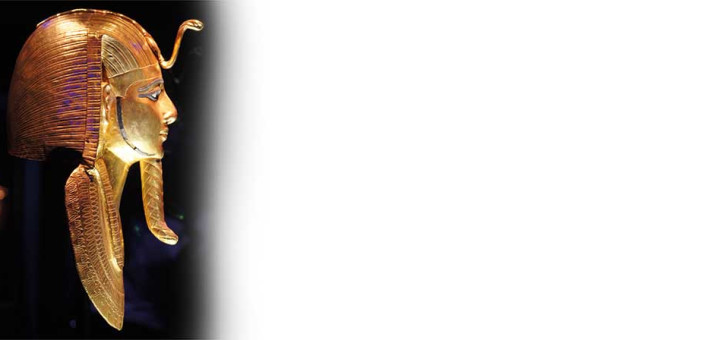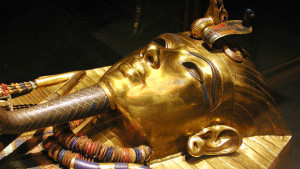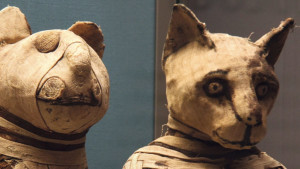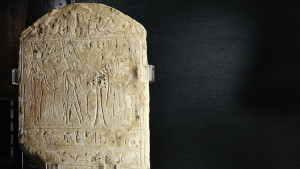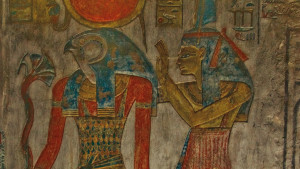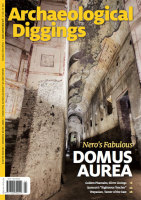Finding an intact tomb would surely be one of the highlights of any Egyptologist’s or archaeologist’s career; think of Tutankhamen and the names of Howard Carter and his sponsor Lord Carnarvon are synonymous. So to unearth four intact burials, three of them royalty and with artefacts as fabulous as Tutankhamen’s within one career would surely seem like a dream. But this actually was the case for French archaeologist Pierre Montet in 1939–40. However, it isn’t as widely known: the finds weren’t as celebrated nor reported to the extent of Tutankhamen’s tomb and its treasure. What could possibly reduce the impact of reporting six tombs, with four golden masks, two silver coffins, sarcophagi, jewellery, gold and silver vessels and a city and a pharaoh referred to in the Bible? It was the onset of World War II with its devastating effect upon humankind that naturally took precedence at the time.
The setting for this unprecedented find was the site of the ancient royal city of Tanis in the northeast of the Nile Delta. To the ancient Egyptians, it was known as Djanet (Gk: Tanis) and is referred to by the biblical name of Zoan in the Old Testament. It is referred to today as San el-Hagar and is 130 km (70 miles) from Cairo. Tanis had been abandoned in antiquity, most likely as the Nile shifted its course, along with political divisions that caused further unrest. A temple for the worship of the Theban triad of Horus, Amun and Khonsu was located here, along with two sacred lakes, the most recent being discovered only in 2009 some 12 m (40 ft) below current ground level.
The site of Tanis contains the royal tomb complexes of the twenty-first and twenty-second dynasties of the Third Intermediate Period of ancient Egypt’s history (c.1070–713 b.c.) and covers 177 hectares (438 acres). Even Napoleon’s Egyptian expedition explored here, producing a plan and an account of the monuments. It is interesting to note that although blocks of stone, statues and reliefs have been found here dating to the Old and Middle Kingdoms and to the pharaoh Ramesses II from the New Kingdom, Tanis was only actually occupied from the reign of Psusennes I (c.1039-991 b.c.). An immense brick enclosure wall surrounding the great temple of Amun was explored and it was evidence from the foundation deposits of the sanctuary within that named this pharaoh; therefore the previous older materials had been usurped and reused.
The strategic location of Tanis in the Delta made this city a prosperous commercial trading centre and the pharaohs successfully ruled from here for around 350 years. In Thebes, in the south of the country, it was the high priests of Amun who ruled. The political environment at the time saw Egypt ruled from two different areas, but a marriage of Isiemkheb, the daughter of Psusennes I from Tanis, to the high priest Menkhepere from the south, showed how closely allied the two ruling parties were. Even the name Psusennes had a link to the south of Egypt, meaning “the star which has appeared at Thebes.”
It was during the 11th year of excavations that Montet and his team discovered a small assemblage of stone and mud brick underground royal tombs near the great temple of Amun at Tanis. It proved to be a most spectacular and unique find. The royal tombs of the pharaohs Psusennes I and his son Amenemope dating to the twenty-first dynasty were discovered intact; both had been buried with golden masks. A further three pharaohs of the twenty-second dynasty—Osorkon II, Takeloth II and Shoshenq III—were also located. Adding to these finds were the burials of Shoshenq II (intact with gold mask) and his army commander Wen-djeba-en-djed (intact with gold mask). A further burial of the prince Hornakht, son of Osorkon II was also located, although it had been disturbed sometime in antiquity.
In a sealed chamber that was named for Psusennes I was an astounding sight—a magnificent and rare falcon-headed solid silver coffin! This was highly significant, as it was the first ever discovered in Egypt. The ruling king of modern Egypt at the time of the discovery, King Farouk, was privileged to be in attendance as the lid of the coffin was raised. However the body was not that of Psusennes I, as was assumed, but of Shoshenq II, an unknown ruler until the discovery. Here was another substantial revelation. Under the falcon-headed coffin was another glorious discovery: a gilded and painted falcon-headed cartonnage had been placed over the pharaoh’s head!
Why shape a coffin and cartonnage with a falcon’s head? It was believed that this was to identify the ruler with the god Horus or the funerary god Sokar. But more surprises lay in wait and this time it was gold. When the cartonnage was removed, it exposed an exquisitely crafted gold mask of the pharaoh Shoshenq II.
The pharaoh had been well prepared for his journey into the afterlife, with even his feet placed in sandals made of sheet gold. These were formed with the soles curled back and joining a band across width of the foot. They were designed for a funerary nature only, not to be worn in life. Two gloriously decorated golden bracelets were upon his arms. They display vertical strips of gold alternating with lapis lazuli, with an inlay of the wedjat eye atop a weaved basket. The symbolism of each eye facing inwards represents the sun and the moon as the eyes of Horus, the ancient celestial god, and offer protection and guidance for the pharaoh on his journey. They are named for Shoshenq I, a predecessor. The point of difference here is timely and substantial: Shoshenq I was the pharaoh known in the Bible as Shishak.
Accompanying Shoshenq II to the afterlife were his mummified organs, secured in four small silver anthropoid coffinettes, each with a nemes head covering with uraeus and placed in protective calcite vases. The silver items were an exceptional and significant find, as this metal was comparatively rare and had to be imported, making it costly. The ancient Egyptians associated silver as the bones of the gods, whereas gold was considered to be the flesh of the gods. Here was a golden pharaoh with a silver lining!
The archaeologists pressed on, noting a granite lined room where a sarcophagus in granite named for the pharaoh Osorkon II and a smaller one inscribed for the prince Hornakht had been placed. Disappointingly, these burials had been robbed, but the canopic jars were still there. Intriguingly, in the sarcophagus of Osorkon II, the remains of gold frames fashioned into falcon eyes led archaeologists to surmise that he had originally been buried in a falcon-shaped cartonnage or coffin as well. Despite the body not being present, there were more than 300 shabtis—small inscribed statues ready for the pharaoh’s bidding in the afterlife—mostly naming Takeloth II, his successor.
A large slab of granite inscribed with the name of Ramesses II, a former ruler of the nineteenth dynasty, blocked a doorway. Could there possibly be more to uncover? Amazingly, yes! Behind it was a massive pink granite sarcophagus, originally inscribed for the earlier pharaoh Merenptah of the nineteenth dynasty (Ramesses II son and successor) of around 170 years earlier. On the top of the sarcophagus was a sculptured figure of a pharaoh in an Osirian pose, arms crossed, while under the lid was the carved figure of Nut, goddess of the sky, with arms stretched, symbolically protecting the pharaoh underneath.
When the lid was lifted, yet another sarcophagus of black granite was revealed, also anthropoid in design. It protected a solid silver coffin, this time with anthropoid features rather than a falcon head. Upon the silver face of the coffin, a gold diadem and uraeus were placed, creating a striking contrast; the rearing cobra defining the authority and kingship. This protected the beautifully moulded golden face mask of Psusennes I beneath, an item skilfully crafted in gold sheet no more than a millimetre in thickness, with glass inlaid eyes, eyebrows and lapis lazuli inlaid in the beard. Psusennes I was prepared for the afterlife with his stunning jewellery inlaid with semi-precious stones in pectorals, bracelets, anklets, rings and amulets. On both the left and right hands, he wore a covering of golden fingerstalls each with the nail incised and with individual golden rings, his toes covered in the same manner. The gold was symbolic to protect the hands and to ensure they would be restored in the afterlife. Finally, the intact burial of Psusennes I was found.
Many magnificent and elaborate funerary items had been placed with the burials and included bowls of silver, gold and electrum, one incised with the image of four young females swimming amid a design of fish and lotus flowers with inlaid glass petals, a fluted bowl in the shape of lotus flowers and inlaid with faience, anklets and rings and the ever-present protective gods formed into amulets. Another rare item was a belt of electrum with an apron frame at the front that once held gold bead netting and was placed upon Shoshenq II.
The highlights of the Tanis royal treasures toured four cities in Australia in 1988-9 in a magnificent and highly successful exhibition called “Gold of the Pharaohs.” But if you wish to see the golden pharaohs in silver lined caskets, they are in the Egyptian Museum in Cairo, right next door to Tutankhamen’s golden burial entourage. So start packing!
Banner Image:
Golden Mask of Psusennes I. Despite the amazing treasures that rival the those of Tuthankhamun’s, the discovery of pharaoh Psusennes I tomb was overshadowed by news of the Second World War. The pharaohs of ancient Egypt surrounded themselves with treasures, mostly fashioned from gold as they believed the proximity of gold gave man the power to return to life.

